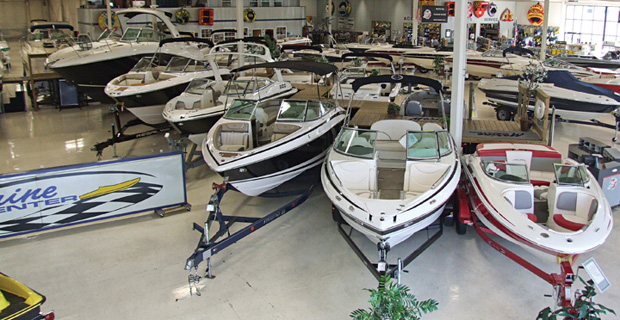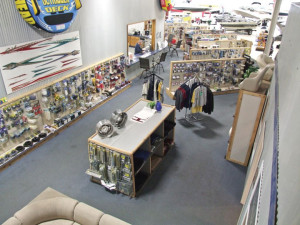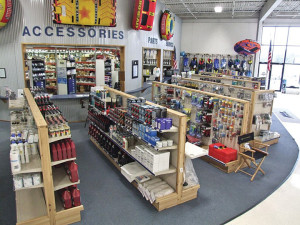Creating a buying atmosphere

The right showroom design can increase sales throughout your dealership
When owner Michael Wood moved South Florida Mastercraft in 2011, he had a clean slate of a dealership to design. With an 8,000-square-foot showroom space in Boynton Beach to fill, Wood put a lot of thought into the new digs and how the layout would affect sales.
“We wanted to be a one-stop shop,” he said.
A dealership’s showroom offers the best format for a store to present itself and its culture and create an environment in which customers want to spend time and, hopefully, money.
Jim Rasmus, president of Retail Design Associates explained about dealership showrooms, “It’s their lifeblood. It’s what attracts and keeps customers coming back, if the showroom is designed to meet [customers’] expectations.”
Typical customers, he said, spend 29 seconds deciding if the store they’ve entered is one they plan on staying in or not. Because of that, the store should be presented in a professional manner, with 80 to 90 percent of the product visible from the door.
“Right off hand, it should be telling the customer that it’s a place that they want to shop in,” Rasmus said.
Traffic flow
 One of the keys to a successful showroom is moving customers from the door to their final destination, while showing off as much merchandise as possible. Rasmus says a planned traffic flow pattern is integral to add-on sales. A showroom should be designed in a way that almost forces a customer to follow a set path. That path should take buyers through most of the departments, so customers can see what’s new and possibly make impulse purchases.
One of the keys to a successful showroom is moving customers from the door to their final destination, while showing off as much merchandise as possible. Rasmus says a planned traffic flow pattern is integral to add-on sales. A showroom should be designed in a way that almost forces a customer to follow a set path. That path should take buyers through most of the departments, so customers can see what’s new and possibly make impulse purchases.
“What it’s doing is it’s telling the customer where you want them to travel and what you want them to see once they come in the store,” Rasmus said.
The goal is to put the departments that are the main traffic draws, such as parts, accessories and service, in the back, so a customer must walk through the new boats before arriving at their intended location. This is similar to what a grocery store does by putting milk in the rear of the store, with higher-margin items showcased in the front.
The back left corner is an ideal spot for the dealership’s magnet departments, as most people are right handed, and right-handed people tend to travel stores counterclockwise, Rasmus said, meaning they’ll naturally explore the right side of the store before realizing the department they’re looking for is on the left.
When designing his showroom from scratch, Wood made sure to locate his pro shop and service departments both in the back of his dealership. Mike Hoffman, owner of Marine Center of Indiana in Indianapolis, did the same when he doubled the size of his parts and accessories department in 2011.
 “We make you walk through all the new boats to get to the parts and accessories, so maybe what happens is maybe you decide to buy a new boat. Worst case scenario is you don’t buy a new boat, but you buy parts and accessories,” he said.
“We make you walk through all the new boats to get to the parts and accessories, so maybe what happens is maybe you decide to buy a new boat. Worst case scenario is you don’t buy a new boat, but you buy parts and accessories,” he said.
Clearance is also an area that should be moved to the back of the dealership, ideally in the rear of the parts and accessories department. It’s no accident that many retailers do this, as, again, it causes customers to see what’s new before hitting the clearance bin.
One of the easiest ways to design a set traffic pattern is to differentiate the flooring from one area to the next. Department stores, for example, often use tile in the main walkways, with carpeting in the merchandise areas. While carpet may not be ideal for a boat showroom, tile can still be used to create flow.
“Use two different colors to even three different colors throughout the store, one for traffic flow, one for units,” Rasmus explained.
Showroom staples
The fixed parts of a showroom should be taken into careful consideration. Flooring, lighting, paint and windows, aren’t changed often, so much thought should go into those staples.

Jennifer Robison, national retail specialist at Tucker Rocky Distributing in the powersports industry, and a 2012 MDCE speaker, recommends that all facets be clean and in working order, with no broken lighting or major issues with the flooring.
“When it starts looking tattered and worn, it makes everything look sort of that way,” she said.
For flooring, Rasmus recommends something that will last 7 to 10 years, such as ceramic or porcelain tile. Trailer tires can bleed onto other types of styles, unless they’re moved every few days. Porcelain is best, he said, because it doesn’t show chips as easily.
The new showroom floor at South Florida Mastercraft was painted before the merchandise moved in.
“We had the whole floor sanded, and then they used an epoxy paint with dried paint chips they put over it, which is nice because it hides the scratches and the chips in the floor,” Wood explained.
A dealership’s flooring and wall paint should be neutral, Rasmus said. He recommends earth tones, such as a cream or light green. The popular battleship gray of the past should be avoided, he said.
Lighting is important when it comes to best showcasing the merchandise. Lighting on the boats should be directed to most accurately show the color of the unit, so customers aren’t surprised when they get their vessel on the water. Economical fluorescent lighting can save on energy costs, and some municipalities offer rebates or special financing for greener technology. Track lighting can also highlight products, especially in parts and accessories. Rasmus recommends dealers seek a professional to help choose the proper lighting and install it.
When looking at his showroom, Wood considered the outside of his store as well as in the inside. Originally Boynton Beach did not want the dealership placing boats outside, however, Wood worked with the city to find a solution. The dealership placed decorative blue glass pieces in an area outside the store, where during the day, a boat can be featured, while at night, it appears as a well-landscaped area. Wood also worked with the city on its tree requirement, receiving an exception to install more shrubs than trees, and moving most of the trees to the rear of the building, preventing the plants from impeding the view of the dealership. Wood also made sure to install a number of large windows on the front of the dealership, which faces Federal Highway.
“It’s well lit every night, so you can see it from the road,” Wood said. “As you’re passing down Federal Highway, you can see the boats in the showroom.”
Cleaning up
Though it’s not the most exciting part of creating a successful showroom, cleanliness is also important. The experts say a clean store looks more professional.
When Retail Design Associates works with a dealership, it provides a 10-point daily inspection checklist for both the inside and outside of the store.
“First impressions are lasting impressions, so the general staff, especially all the management level, needs to do this store review prior to opening the front door,” Rasmus said. “In other words, it’s a no-excuse situation.”
Robison recommends dealers restock shelves and run a vacuum over any carpet each morning or evening. She advises that managers stick with this process, to get employees helping with the store, rather than spending their pre-opening time gossiping over coffee.
“Doing a physical walkthrough every day is imperative,” she said. “No one wants to buy stuff that looks shabby.”
In addition to other cleaning tasks, Wood has his staff mop floors every Friday, and a deep-clean cobweb and dust check is completed at least once a year.
Fixtures
 Though boats pretty much stand on their own in a showroom, parts and accessories require fixtures for proper display. Generic retail fixtures work well in any dealership. They can serve any brand and a variety of product.
Though boats pretty much stand on their own in a showroom, parts and accessories require fixtures for proper display. Generic retail fixtures work well in any dealership. They can serve any brand and a variety of product.
The three basic features most fixtures should include are flexibility, adjustability and mobility, so one unit can highlight a variety of items, Rasmus said. Mobility is especially key for clothing, lifejacket, or wetsuit fixtures.
Branded point of purchase displays can be used, but the experts say they should be placed with discretion. Also, each should only be used with the product that it’s advertising, and not with other brand’s items.
End caps on stationary shelving are ideal places to display lower-priced impulse products.
“End caps are your features, and they should be changing frequently, certainly every season. It’s where you want to focus on high-turn products,” Robison said.
She advises dealerships to consider creating lifestyle zones throughout the showroom, displaying products that go along with a variety of boating lifestyles. A pontoon display, for example, could feature a family of mannequins that seem to be enjoying a day on the water. The unit could be decked out with a ladder, stereo system, tables, additional seating and a top. A jet boat display could feature wakeboard racks holding a couple wakeboards, towrope, a cooler, or other recreational items. Similar lifestyle areas can be created for other boating activities, depending on which brands the dealership carries and what the store’s typical customer participates in.
“A lifestyle zone really kind of refers to the end user, the lifestyle they use with a particular vehicle, so it’s reminiscent of sporting goods,” Robison said.
The lifestyle zones should be focused on the primary demographics of each dealership, so the store doesn’t feel compelled to showcase every boating activity in its region. Those lifestyle areas can be placed throughout the main showroom, or one or two can be featured closer to parts and accessories, playing up some of the available product and shining a new light on that boat. Boats that aren’t in a lifestyle section should be spread far enough apart so consumers can see them clearly and so they look approachable.
“Your job is to sell as many units as you can, but you have to think what the customer’s mindset is,” Robison said. “When they’re just lined up, it’s just a factory-farmed installation.”
Keeping things fresh
 Though every showroom has features that are almost always the same — from the overall look of the facility to the placement of the departments — small changes should be made as often as possible.
Though every showroom has features that are almost always the same — from the overall look of the facility to the placement of the departments — small changes should be made as often as possible.
Constantly changing the showroom is a high priority at South Florida Mastercraft. Once a month, the dealership moves its boats around the showroom, so not only do customers walking in see something different, but so do those driving by.
“I think any change that you can do to get your customers to keep coming back in your showroom, that’s what we’re trying to strive for,” Wood said.
Moving the boats around not only piques new customers’ interest, but it also instills a sense of urgency in return customers. As boats are shifted, it appears that more have been sold, even if they’ve simply been moved to another part of the showroom or outside.
“If they see the same stuff in the same spot every time, it doesn’t entice them to look around,” Wood said.
The dealership places its clothing on roller racks, so they can be moved to make the pro shop look different. South Florida Mastercraft also recently added paddleboards, kayaks and other water-related apparel and accessories, along with Evo-Skate electric skateboards, to its offerings.
“At least we get them to come back in, so they’re able to see the new product, the new boats that are out there,” Wood said, adding that before the move, the dealership was inevitably sending customers to its competitors to purchase parts and accessories.
Wood’s store also added a Product of the Month, which it markets through its e-newsletter and displays at the front of the dealership. That product is a way to feature the latest goods, while also luring customers into the dealership.
Marine Center of Indiana keeps its store looking new with constantly well-stocked product.
“We have a reputation of if you come here, we have it, and most of the time we do,” Hoffman said. “If not, we work closely with our suppliers to try to have it within 48 hours.”
What’s important to remember, Robison explained, is that dealerships are designed to put the products in front of the customers’ eyes in a way that showcases what the store has to offer.
“As a store, your job is promoting product,” she said, “not just to house it, but to explain it and promote it to your customers.”
See sidebar to this article: Redesigning a showroom brings positive ROI




